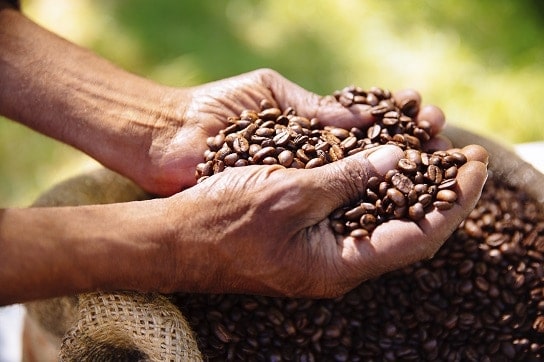 By now, word has probably reached you that coffee can be excellent for your acne. It’s overflowing with antioxidants, it may shield your skin from sunlight, and its bonus compounds are plentiful.
By now, word has probably reached you that coffee can be excellent for your acne. It’s overflowing with antioxidants, it may shield your skin from sunlight, and its bonus compounds are plentiful.
But what about decaf coffee? There’ll probably be a flash of lightning and a thunderstorm just for mentioning the name, given how maligned this “healthy alternative” is. The death before decaf movement is as strong as ever, calling decaf pointless, like a door without handles, like a chocolate teapot, etc.
Should you join their ranks? If your skin has a caffeine sensitivity, should you just give up coffee altogether?
The short answer is that decaf has its faults, but nowadays, is fairly acne-friendly overall. This article is not about caffeine itself; we investigated its easily manageable problems like increasing stress hormones here. It’s about the quality, nutritional differences, and nasty hidden chemicals – the rest of the acne roster.
Note that decaf isn’t 100% caffeine free. In the USA, the FDA mandates that 97% of caffeine is removed, while the EU is stricter at 99.7%. Your average cup of coffee might contain 180mg of caffeine compared to 5.4mg for decaf.
Here’s the truth about decaf coffee:
FIRST OF ALL – the decaffeination methods
The whole decaffeination tale started with Ludwig Roselius, who according to legend, became a man on a mission after witnessing his father slowly die from coffee addiction.
One stormy night, his freight ship supposedly flooded with sea water. When the beans were tested, the flavour remained delicious, but the caffeine was missing.
For a moment, Roselius probably felt like the king of the world. Taking inspiration, he used brine water to invent the first decaffeination process in 1903, and patented it in 1906. Unfortunately, the solvent extractor was benzene, now confirmed to be a carcinogen.
Thus the reputation was born that decaf coffee was toxic sludge. Until the 1970s, all decaf coffee was made with chemicals, although benzene itself faded away decades ago. A variety of villains have made tempting propositions: trichloroethylene, carbon tetrachloride, acetone, ammonium hydroxide, and sulphuric acid.
However, as of 2019, the four most common decaffeination methods are…
Methyl chloride – the top decaffeination method worldwide. Firstly, manufacturers increase the moisture level of beans through steaming. Then they inundate them with methyl chloride, a chemical solvent, which binds to the caffeine and removes it. Finally, the beans are heated to remove the residual solvent and moisture. Normal service resumes. Decaffeination = complete.
This is the direct method, and the indirect is when coffee beans are soaked in water first, to separate the caffeine. Instead of the beans, this liquid is treated with methyl chloride, and the flavour-rich water remixed into the bean.
Right now, 70% of coffee worldwide is decaffeinated using solvents.
Ethyl acetate – a less controversial solvent using the exact same methods. Ethyl acetate is found in fruits, although the solvent version is actually derived from petroleum. Nevertheless, it is easily digested by the human body.
Carbon dioxide – an expensive method, and therefore mainly used by big retailers, one being the UK supermarket Sainsbury’s. Coffee beans are poured into a tank which is pumped full of carbon dioxide, at 1000 pounds of pressure per square inch.
Somehow, this only binds to the caffeine alkaloid, leaving the antioxidants intact. The caffeine-rich liquid flows into the absorption chamber, where the CO2 separates into gas for reuse. An otherwise chemical-free method.
The Swiss water method – 55 years in the making, this double organic certified process was discovered in 1933. Production was low and the taste inferior, until 1988, when breakthroughs finally allowed the first commercial brand.
The beans are soaked in hot water, which then flows through an activated charcoal filter. This filter only captures larger caffeine molecules, leaving the remaining water dripping with flavour.
The original beans are discarded, wasted, but in round 2, the new beans are soaked in the fresh flavour-rich water. Thus, only the caffeine is sucked out, leaving the flavour intact. Premium decaf brands use this strategy, despite foolishly forgetting to mention it on the label sometimes.
Do the decaf chemicals cause acne?
 The Swiss water method is easily the cleanest, and carbon dioxide is fine too. But is methyl chloride a legitimate threat to clear skin?
The Swiss water method is easily the cleanest, and carbon dioxide is fine too. But is methyl chloride a legitimate threat to clear skin?
On paper, it definitely looks dodgy, because methyl chloride is mostly detoxified through the glutathione pathway. Glutathione is vital for clear skin, and when inhaling the chemical, mice have been shown to lose 45% of their supplies. Methyl chloride is converted to s-Methylglutathione, then S-methylcysteine, and then eliminated.
The cytochrome P-450 pathway also detoxifies a chunk (the same pathway that detoxifies caffeine), and here, it’s metabolised to the highly inflammatory formaldehyde.
However, the FDA’s safety limit in coffee is 10 parts per million, and the average decaf bean contains 1 part per million. It’s true that acne-causing horrors like BPA were also deemed fluffy and lovable once, but methyl chloride is a unstable gas, and vaporises at 104F. Meanwhile, all coffee beans are roasted at 400F for 15 long minutes, including decaffeinated. Ethyl acetate is just as volatile.
My recommendation is to be strict with chemicals, never giving them the benefit of the doubt, particularly pesticides in fruit. However, in 1985, the FDA deemed the decaf methyl chloride threat to be “so low as essentially non-existent“, and for once I’d have to say they’re correct. The only fear left is undetectable vaporisation by-products which linger on and fulfil its acne-causing destiny.
Does decaf coffee have less antioxidants?
Antioxidants are one of the coffee’s greatest selling points for acne. In fact, coffee is the average American’s number one source of antioxidants, but it’s theorised that decaf contains less, blasted into orbit by the pummelling extraction process. The altered flavour and colour support these theories.
The studies have their outliers, but decaffeinated coffee is consistently lower in acne-clearing antioxidants:
ONE – when tested against the free radical DDPH, normal coffee had 15% higher antioxidant activity than decaffeinated. The scientists blamed “a slight loss of antioxidant substances with decaffeinization procedures” (2010 study).
TWO – regular coffees were tested from 12 different countries, including Jamaica and Guatemala, and 2 decaffeinated coffees from Columbia and Brazil.
Expresso, filter, or Italian brewing procedures barely changed the antioxidants. However, out of the 14, Brazilian decaf ranked last for antioxidants, while Colombian decaf ranked 4th last.
That said, every coffee cup still had bountiful antioxidant levels. First and second ranked were Vietnamese and Ugandan regular (2007 study).
THREE – this time, phenolic compounds such as anti-inflammatory tannins were no different in the decaffeinated and normal coffee. However, decaffeinated was inferior at deactivating the free radical DDPH.
Its overall antioxidant capacity was lower, as were phenolic acids, which include chlorogenic acid, a famous heart protector with anti-inflammatory properties. Decaffeination must affect some antioxidants more than others (2014 study).
FOUR – this 2006 Spanish study was much messier. In non-roasted green coffee beans, chlorogenic acid was 16% higher in decaffeinated samples but in roasted decaf beans, chlorogenic acid was 3-9% lower. Meanwhile, another powerful antioxidant called 1,5-gamma-quinolactones was 5.5-18% higher in roasted decaf beans.
FIVE – some Serbians joined the party, measuring the popular FRAP antioxidant scale. It was a clear cut comparison: normal roasted instant coffee scored 92-94, while decaffeinated instant achieved 76-84. Filter coffee was inferior as a group, but decaffeinated was weaker within it, with a 16 FRAP score compared to 27-36 (2017 study).
Does decaf coffee use poor quality beans?
 It’s the single biggest reason behind decaf coffee’s anthill flavoured reputation, and if true, clear skin would also be in jeopardy.
It’s the single biggest reason behind decaf coffee’s anthill flavoured reputation, and if true, clear skin would also be in jeopardy.
Forget the decaffeination process – what if the antioxidants were missing to start with? That’s ignoring the inflammatory mould contamination.
The truth is a simple matter of economics. Extracting caffeine with chemicals or carbon dioxide costs money, and to keep their profits intact, coffee sellers choose the cast-off beans. The beans that farmers know are rubbish and are desperate to flog off.
Furthermore, some coffee companies believe that decaffers care less about the taste; they’ll take what they can get. They also gravitate towards cheaper, bitterer robusta beans compared to arabica.
Back in the 1970s, decaf coffee was the leftovers from energy drink production. Essentially, they extracted the caffeine, which was their real goal, then noticed vast piles of coffee beans stretching out in front of them. As an afterthought, these were then sold on for decaf coffee, for a little bonus profit and little thought for quality.
Even the starting point beans are dodgy. Just think: a wise coffee grower is always going to sell his premium, antioxidant rich beans to coffee companies first. The energy drinks companies don’t care anyway, because all they want is the caffeine.
The good news is that decaf coffee has improved massively recently. This time, economics has saved us.
As the horrors of cheap decaf spread, eagle eyed coffee companies recognised the potential for one that was actually decent. By boasting about fine flavour (and therefore antioxidants), their profits become dependent on providing it.
Energy drink cast offs are still going strong, but higher quality brands are now popping up everywhere. It’s true: an aeroplane or prison cup of decaf will be devoid of acne benefits, but choose your coffee company carefully and your skin will thank you. However…
Decaf coffee is higher in mcyotoxins!
Regardless of the starting beans, an undeniable fact is that decaffeination itself also allows mould to thrive. Specifically, mycotoxins like ochratoxin A and aflatoxin B1.
Mycoctoxin contamination is a huge problem in coffee, beer, chocolate and peanuts alike. You can read this article for the full acne-causing biography, but the gist is massively increased inflammation and massively decreased antioxidants.
Mycotoxin is the word that keeps coffee aficionados up at night (apart from the caffeine of course). The debate is still raging, but look at these studies:
One – in green coffee beans, up to 80% were contaminated with aspergillus flavus, the mould species that manufactures mycotoxins. For ground roasted coffee, it was 71%, and adding liquid caffeine crippled the mould by 50%.
Good news for normal coffee: roasting decreased the aflatoxins by 42.2-55.9%. Bad news for decaffeinated: it contained at least 50% more aflatoxins overall (study).
Two – decaffeinated coffee beans were significantly higher in ochratoxin A, although if they were decaffeinated before roasting rather than after, the difference was smaller. Meanwhile, 1% and 2% caffeine solutions completely disabled the aspergillus ochraceus mould and its ochratoxin A production after 21 days (study).
Three – scientists tested coffee from every corner of Spanish society, and only 5 out of 100 contained mycotoxins above the (dubious in my opinion) safety limits. Yet 2 were decaffeinated coffee, and 1 was a decaffeinated coffee pill. The other two were concentrated coffee pills (study).
Decaffeinated coffee is covered with aspergillus moulds and their mycotoxin sidekicks. The specific power of caffeine has been known since the 1980s.
To produce mycotoxins, moulds use rapidly digestible carbohydrates like glucose. However, caffeine inhibits glucose transporters within the cell, ultimately decreasing glucose absorption by 50%. Scientists have placed aspergillus and glucose side by side in a petri dish, and when caffeine was added, dramatically less glucose vanished.
Caffeine is unique; closely related compounds like theophylline don’t work. Caffeine can slow the expansion of moulds themselves too, by up to 90%; it’s effectively the bean’s personalised antibiotic.
It’s different to say, lupulone from the beer-flavouring hops herb. Caffeine causes no structural damage to the mould cell itself, no shrinkage or membrane leakage. The smart money is that the crippling of glucose also starves aspergillus of its fuel source. Caffeine also decreases the respiration of the mould cell.
The question is the significance, whether decaf’s mycotoxin levels are still totally harmless.
A 50% increase in minuscule is still nothing. The common argument is that “a cup a day won’t hurt you”, but for many coffee lovers that’s a fantasy. Combined with peanuts or beer, your intake will stack up.
However, the biggest threat is sensitivities. Many claim that their aching joints and brain fog become history once they dodged all mycotoxins. It’s unproven, but completely conceivable that as ancient (if toxic) substances, humans have a gene that controls mycotoxin detoxification, genes with significant variation.
The definitive verdict
It’s obvious by now that we’re not exiling decaf coffee to the wild badlands of acne villains just yet. The truth is that lifestyle factors are particularly important.
Are your stress levels high? Choose decaf. Do you dislike fruit and vegetables and therefore their acne-clearing antioxidants? Choose caffeinated. Are you exposed to inflammatory pesticides and cosmetics chemicals? Choose caffeinated and dodge mycotoxins.
There are dozens of scenarios, so here’s your all-encompassing verdict.
If you know that your skin is sensitive to caffeine, then decaf is great, if higher quality and preferably organic. If you’re not sensitive, then the minor problems of decaf make it worth sticking with regular coffee. This is particularly true if your budget is limited.
However, the classic acne rules for caffeine still apply, two or three cups daily to avoid elevated stress hormones. Therefore, if you want more antioxidants, or pleasure of course, you can add a daily high quality cup of decaf as well.
If all else fails, you still have one trusted friend: trial and error.
THE FUTURE – naturally decaf coffee
Soon though, chemical decaffeination may be totally irrelevant. In 500 years, decaffeination might seem as quaint and laughable as witch burnings and flat earth believers seem now.
Why? Because in 2004, scientists discovered 3 arabica trees which naturally produce no caffeine. 3000 were tested, and the so-called CA1, CA2, and CA3 lacked the all-important caffeine synthase gene. Instead, they accumulated theobromine, the nervous system stimulant found in chocolate.
Several low-caffeine coffee trees were known in the jungles of Madagascar, but they were bitter and unfarmable. These 3 strains were related to the popular coffee arabica, and therefore have excellent prospects for breeding the taste into the coffee we all know and love (or are addicted to). Ultimately, they were dubbed Coffea charrieriana.
Obviously, it’s now 15 years later, and nothing has happened. There are many obstacles, like sparse branching, strange canopy shapes, and low productivity. The caffeine-free gene is recessive, disappearing when bred with tastier strains. If grown in fields, the coffee could cross pollinate with nearby robusta crops and lose the gene again.
Even if the miracle species tasted fantastic, poor harvests might make it unprofitable to sell compared to robusta or arabica, the two dominant species worldwide.
However, scientists are sure that natural decaf will appear, or decaffito as it’s been trademarked in Brazil. Research started back in the 1980s, when Paulo Mazzafera became convinced that a naturally decaffeinated coffee tree was hiding in nature. It took 20 years to find AC1, AC2 and AC3, and in another 20, our patience might pay off again.
Around 2003, the Brazillian government operated a top secret lab, where scientists were forbidden to speak out and even the location was hushed up (probably deep within the Amazon rainforest). Another great development was in 2006 when Mazzafera dropped 28,000 seedlings in a solution designed to cause mutations. No, he didn’t trip, fall in and grow a giant third eyeball, but 7 resulting coffee trees had negligible caffeine levels.
Again, the problem was the bitter taste, and that’s the final barrier we need to break through. It’s all cross-breeding, hybridisation, farming techniques and genetic analysis, an endlessly complex code, but one which we will surely crack, maybe in 50 years, maybe in 10.
A problem could be extra fungicides at first, to compensate for the lost mould-killing caffeine. However, if the wild Madagascan trees can withstand infection, they must have an alternative antibacterial system, which farmers could preserve.
Mark my words, a naturally decaffeinated coffee is on the way. The best part is that antioxidants will be unaffected and chemicals will be missing.
Thanks for reading!